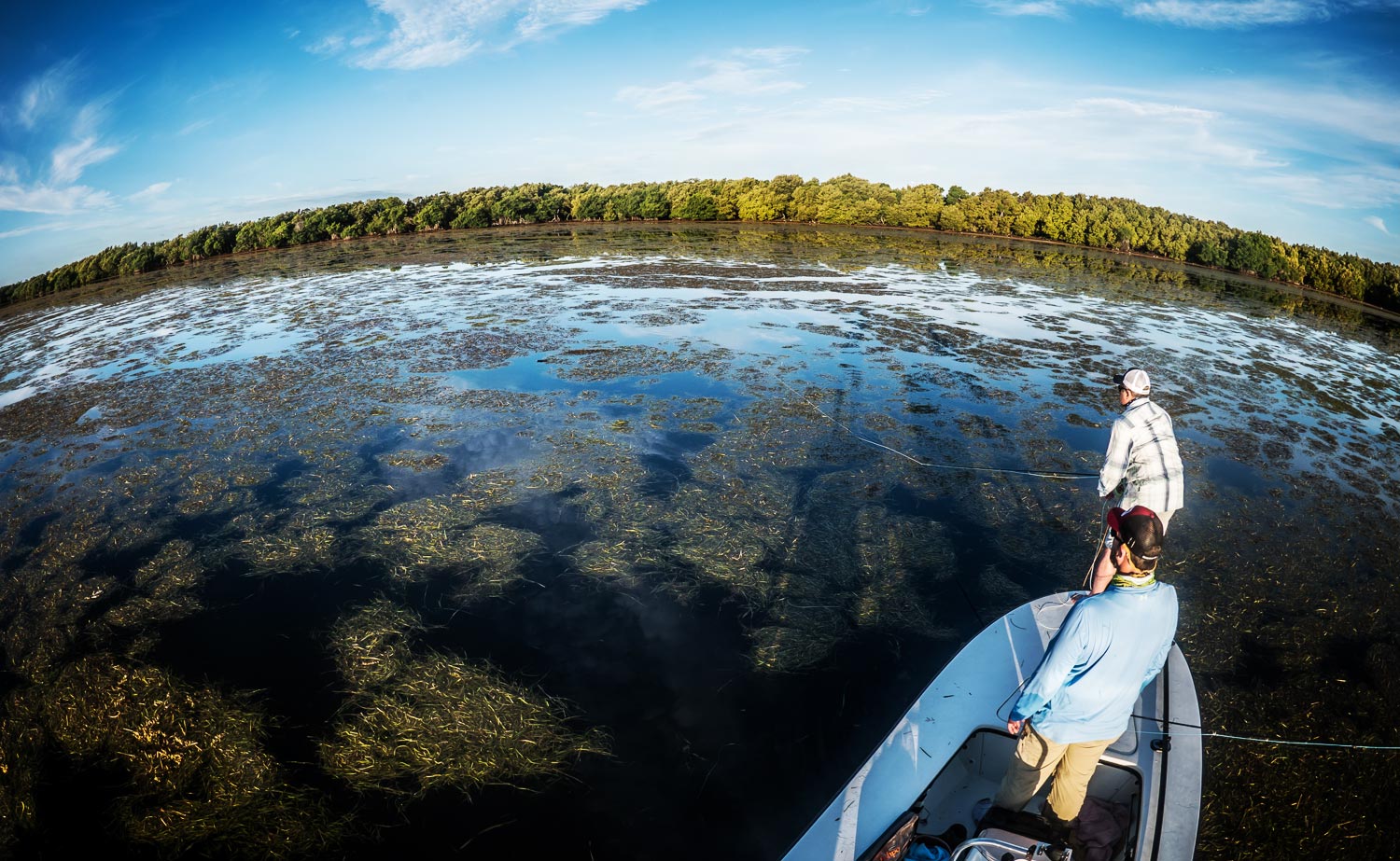By Louis Cahill
It’s already plenty warm by 6:00 AM.
The hot pink band hugging the horizon and lighting up the water foreshadows the brain-baking heat that will be here any minute. It’s going to be another brutally calm day in the Florida Keys. We’re poling quietly down the flat, the little Dolphin skiff slicing the mirror as we go.
My buddy Scott is on the bow while I apply thick white sun screen like cake frosting. My good friend Joel Dickey is on the platform and he seems a little fidgety. We found fish here the previous morning within just a few minutes, but it’s pretty quiet here now. Joel keeps looking over his left shoulder, like he’s being followed. After several glances he stops, fixed on the horizon.
“Naw, that’s…there’s somethin’ goin’ on over there,” he mutters. “Reel up Scott, we’re going over there.”
My eyes aren’t what they used to be. We’re halfway there before I see the birds. They’re working hard on the back side of a little bay. I can just make out the edge of a huge raft of floating weed. The little bay is choked with it. We come off plane, well away from the raft. Joel mounts the platform and takes up in quiet.
“You here that?” Joel asks. I don’t of course because I’m deaf as a post but Scott hears it and you can tell he’s excited about it, whatever it is.
“They’re crushing back there.”
The raft is about the size of a football field. I guess, I never played football. I played soccer and it’s about the same thing. Every so often the grass is interrupted by hot tub sized patches of open water. And in every one of those hot tubs there’s a tarpon working. Rolling and crushing shrimp.
Once in a while you’ll see this happen, when the weather is hot and still. It’s hard to believe that the ocean can run out of oxygen, but it does. In spots any way, when the conditions are just right. The warm water holds less oxygen than cooler water. When it’s calm at night and the turtle grass isn’t producing oxygen and there’s no wind to stir the surface, the shrimp start to suffocate. They come to the surface to find air and they seek the cover of the grass. Too bad for them that the tarpon know all about it.
These fish are little guys. Ten to thirty pounds but they are tarpon to the bone. So here’s the challenge. To make a pin-point cast, of sixty to seventy-five feet, into the far side of one of those openings, where you can get a couple of strips off before your fly is in the grass. Time the cast so the fish rolling in the open water is on his way back up to the surface and seal the deal ASAP.
Feeding them will be the easy part. Once you stick them they go ballistic. They jump and run and jump and run, sewing all of that grass together with your fly line. It’s just like fishing frogs for bass, except that’s a twenty pound tarpon you’re horsing out of the grass, not a three pound bass.
The casting, it turns out, is easier than you’d think. Having a clearly defined target really helps your target picture and if you’ve been practicing your casting, it’ll be simple. You have been practicing, haven’t you? We pole along the edge, sticking the bow into the grass here and there. Scott makes a perfect cast deep into the raft and just when we think it isn’t going to happen, his line comes tight and a bright silver bullet goes bouncing off across the raft. In a few seconds he’s gone and Scott is left with a mess of line and grass. That’s a win in tarpon fishing though. It’s about jumping, not landing. I land the next fish but we fumble him before we get a photo.
Joel ties on one of his floating shrimp patterns, which he will not let me photograph or even describe. It’s deadly and we soon learn that the fish will bust through the grass to take the fly after it’s been stripped completely out of the water. That’s a first for me. I’ve joked for years about catching snakehead or mud skipper on land but this is way better.
After about a half hour the sun is full up and the turtle grass starts doing its job again. The shrimp return to the safety of the bottom and the fish vanish as tarpon like to do. It’s time to roll back to the dock and get some breakfast and then a nap before heading out again in the afternoon. What a morning. Next time I come to the Keys in the summer, I’m bringing some frog patterns.
Here’s a video of Scott hooking up.
Louis Cahill Gink & Gasoline www.ginkandgasoline.com hookups@ginkandgasoline.com Sign Up For Our Weekly Newsletter!


Looks like a whole lot of fun to me! Good job Scott!
Way to go Scott, glad you and Louis are having a great time
Thanks Louis for a great read into the vid. It looks l super fishy,